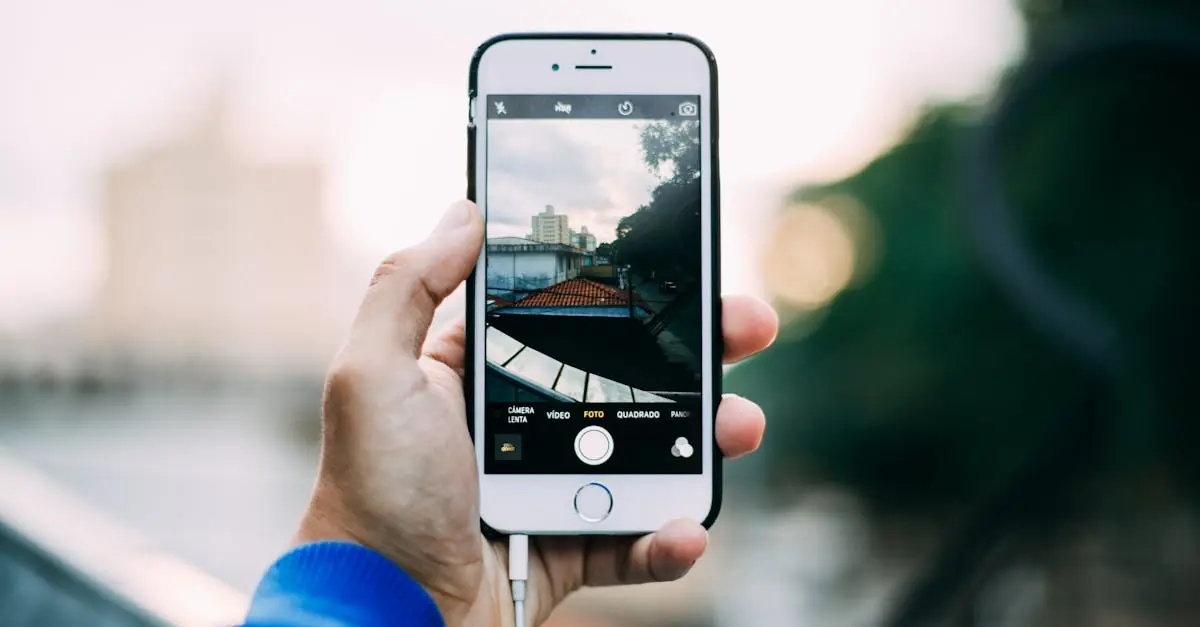In a world where every pixel counts, managing photo file sizes on an iPhone can feel like a high-stakes game of digital Tetris. Whether you’re trying to free up space for that adorable cat video or simply want to send a picture without crashing your friend’s phone, knowing how to shrink those hefty images is a must.
Table of Contents
ToggleUnderstanding Photo File Sizes
Managing photo file sizes on an iPhone involves recognizing how image dimensions and quality affect storage. Digital images consist of pixels; more pixels typically mean higher detail, leading to larger file sizes. It’s essential to understand that file formats play a crucial role. JPEG files, for instance, compress images effectively while maintaining quality.
Resizing images alters file sizes significantly. Higher resolution images take up more space, which can limit available storage on devices. A photo measured at 12 megapixels can consume around 3 MB, while lower resolution images might be under 1 MB.
Knowing the implications of file sizes helps when sharing photos. Large files not only take longer to upload but may exceed recipients’ storage limits. Several messaging apps impose size restrictions, often capping image uploads at 5 MB. Therefore, choosing appropriate file sizes ensures seamless sharing experiences.
Compression methods also help when reducing photo sizes. Using tools or apps that specialize in file size reduction can save significant space without substantial quality loss. Various apps offer options for adjusting quality settings, allowing users to find the right balance between image clarity and file size.
Lastly, staying aware of storage limits provides more control. iPhones come with limited storage; understanding how photo sizes impact this can lead to better management. Regularly checking storage usage can prompt timely actions such as deleting larger, unneeded files.
Methods To Change Photo File Size On iPhone
Changing photo file sizes on an iPhone can enhance storage management and simplify sharing. Here are effective methods to accomplish this.
Using the Built-In Settings
iPhone users can utilize the built-in setting to adjust photo quality and size. Navigate to the Settings app, select Camera, and then choose Formats. Opt for High Efficiency, which converts images to HEIF format. HEIF files consume less space than standard JPEGs while maintaining quality. Additionally, when sending images via AirDrop, select the option to optimize the file size. This ensures photos are compressed for easier sharing without compromising clarity.
Using Third-Party Apps
Third-party apps offer advanced options for reducing photo file sizes. Several apps exist specifically for this purpose, such as Image Size and Compress Photos. Users can import images and select desired dimensions or quality settings. Many of these apps allow batch processing, making it easy to resize multiple photos simultaneously. Additionally, with built-in compression algorithms, these apps can significantly decrease file sizes while preserving essential image quality.
Tips For Optimizing Photo Files
Optimizing photo files on an iPhone enhances storage efficiency and improves sharing capabilities. Effective strategies make a lasting impact on reducing file size.
Choosing the Right Format
Selecting the appropriate file format plays a crucial role in managing photo sizes. HEIF format offers superior compression, resulting in smaller files without losing quality. JPEG is another common choice, balancing image quality and file size well. Experimenting with both formats helps users find the best option for their needs. Always consider the recipient’s device capabilities as certain formats may impact compatibility.
Compressing Images Without Losing Quality
Compressing images effectively maintains visual integrity while reducing file sizes. Various apps like JPEGmini or Compress Photos allow users to shrink files significantly with minimal quality loss. Adjusting compression settings provides further control over the balance between clarity and size. Batch processing options enable quicker handling of multiple images at once, streamlining the optimization process. Familiarity with these tools empowers users to enhance their photo-sharing experience while managing storage efficiently.
Managing photo file sizes on an iPhone is essential for optimizing storage and enhancing sharing capabilities. By understanding the impact of image dimensions and formats users can make informed decisions that streamline their digital lives. Utilizing built-in settings and third-party apps allows for effective resizing and compression without sacrificing quality.
Experimenting with formats like HEIF and JPEG can yield significant benefits in storage efficiency. With the right techniques and tools users can easily adjust their photo file sizes to fit their needs. Staying proactive about storage limits ensures a smoother experience when capturing and sharing memories.




